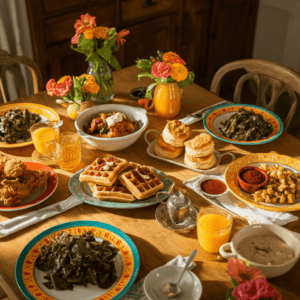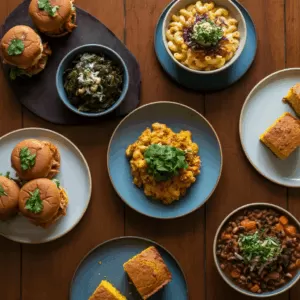Traditional recipes are more than just ingredients and instructions; they represent culture, history, cultural heritage, and family.
These valued dishes, handed down over time, show the unique influences of different regions and climates, highlighting the flavors, culinary practices, and techniques that define a community’s cooking style.
We will explore what makes a recipe traditional, share examples from various cultures, and discuss the importance of preserving these culinary treasures and food traditions for the future.
Join us in celebrating the rich culinary heritage found in every bite, exploring the recipe origins and historical context that enrich our meals.
- The Importance of Traditional Recipes
- What Makes a Recipe Traditional?
- The History of Traditional Recipes
- Examples of Traditional Recipes from Different Cultures
- Why Traditional Recipes Should Be Celebrated and Preserved
- Frequently Asked Questions
- Why is it important to focus on traditional recipes and their history?
- What can we learn from studying traditional recipes and their history?
- How have traditional recipes been passed down through generations?
- What role do traditional recipes play in our daily lives?
- Why do traditional recipes hold such a special place in many cultures?
- How can we keep traditional recipes alive in a modern world?
The Importance of Traditional Recipes
Traditional recipes are vital to culinary history, linking generations through food traditions, folklore, and heritage cuisine. These recipes are more than just nourishment; they represent cultural identity, community meals, and connections, showcasing the unique flavors and historical influences of different regions.
By preserving ancestral dishes and sharing family recipes, we honor our gastronomic heritage, food storytelling, and the stories from our past. Exploring these culinary traditions helps us value the diversity of cultural dishes, historical dishes, and the skill behind these time-honored meals.
What Makes a Recipe Traditional?
A recipe is considered traditional when it reflects its origins, cultural significance, and historical significance, often passed down through generations. Traditional recipes use locally sourced, authentic ingredients that match regional cooking practices, emphasizing traditional food preservation and culinary customs.
They follow historical cooking methods, traditional cooking tools, and techniques that have evolved over time, highlighting a culture’s culinary development and recipe evolution. These dishes not only nourish but also tell the stories of the people and traditions behind them, connecting us to our culinary roots and culinary lineage.
1. Passed Down Through Generations
Family recipes are valuable treasures passed down through generations, connecting us to our culinary heritage, family cooking, and personal food memories. These recipes preserve oral traditions and kitchen folklore, with stories and techniques shared verbally, ensuring that flavors and cooking practices continue within families.
Each dish prepared evokes nostalgia, food memories, and a connection to ancestors, reinforcing cultural identity and family ties. These recipes signify more than just ingredients; they represent moments of love, laughter, and togetherness, often recalling special gatherings, celebration foods, and culinary storytelling.
When families unite to recreate these traditional dishes, they preserve their heritage, culinary storytelling, and create new memories, blending old traditions with new experiences. The kitchen becomes a special place where food moments turn into emotional stories, nurturing relationships, food rituals, and teaching lessons about patience and tradition.
Passing down these recipes, along with the love they represent, enriches family history, culinary lineage, and keeps traditions alive for future generations to embrace.
2. Uses Traditional Ingredients
Traditional recipes rely on specific, often locally sourced ingredients that reflect a culture’s agricultural practices, traditional food markets, and regional flavors. Using these ingredients preserves authenticity, culinary identity, and highlights the unique tastes that characterize heritage cuisine.
This connection to local produce not only improves flavor but also ties the dish to its historical context, recipe authenticity, and shows the importance of ingredient sourcing in cooking.
Incorporating traditional ingredients in cooking connects us to the past, allowing chefs and home cooks to honor ancestral techniques, age-old recipes, and flavors. Each region has its distinct elements, such as heirloom grains, indigenous herbs, or locally caught seafood, which enrich the dishes and tell stories of cultural identity, recipe narratives, and environmental preservation.
Prioritizing these ingredients promotes sustainability, folk cuisine, and supports local economies, fostering appreciation for the agricultural resources that shape culinary traditions. Ultimately, using these traditional components enhances the dining experience, offering flavors that are authentic, traditional flavors, and steeped in history.
3. Follows Traditional Cooking Methods
Following traditional cooking methods is key to maintaining the authenticity of recipes, historical flavors, and the true flavors of dishes. These historical techniques often involve specific methods, traditional cooking tools, and traditional baking that have been perfected over centuries.
By sticking to these practices, cooks ensure that each dish stays true to its origins, culinary customs, while also allowing for adaptations that suit modern tastes.
These age-old methods provide unique textures, traditional food preparation, and flavors that are difficult to achieve with modern cooking shortcuts. For example, using a wood-fired oven or hand-ground spices can greatly enhance a dish with subtle flavors, traditional dining, that improve its taste.
As both culinary professionals and home cooks explore new recipe variations, it’s important to remember that the essence of great cooking is found in these traditional techniques.
Balancing tradition with modern changes honors the cultural importance, recipe evolution, of dishes and enriches the dining experience, fostering a deep appreciation for the art of cooking.
The History of Traditional Recipes
The history of traditional recipes is closely linked to culinary history, historical gastronomy, tracking the origins of food customs, food rituals, and the development of regional cuisines around the world.
Historical gastronomy, food anthropology, shows how these recipes have changed over time, influenced by geography, climate, and cultural interactions. Understanding how these recipes evolved reveals the unique flavors and techniques that characterize different culinary traditions, recipe authenticity, highlighting the richness of gastronomy through the ages.
1. Influence of Geography and Climate
Geography and climate significantly shape traditional recipes by influencing available ingredients, cooking techniques, traditional flavors, and regional flavors. The climate determines seasonal produce, affecting food customs, dietary customs, and recipes passed down through generations. This geographical impact contributes to diverse culinary traditions, culinary evolution, as communities adapt their cooking to use local resources, creating unique flavors.
For example, in the Mediterranean, where the climate is warm and sunny, olive oil, tomatoes, and fresh herbs are common in local dishes, emphasizing fresh ingredients, regional specialties. In contrast, colder regions like Scandinavia rely on root vegetables, cured fish, and hearty grains, reflecting a focus on preservation, traditional food preservation, and sustainability.
These distinct flavors come from both the ingredients and cooking methods, such as slow braising of meats in colder areas, flavor profiles, or light grilling of vegetables in warmer places.
Each adaptation tells a story of resilience, recipe connections, and creativity, showing the close link between local geography and culinary practices.
2. Cultural Influences
Cultural influences play a key role in shaping traditional recipes through exchanges and interactions between different communities, cultural expressions. These interactions create gastronomic diversity, blending ethnic cuisines, ethnic foods, into new culinary traditions while preserving recipes with historical importance.
Sharing recipes becomes a way to connect people with broader food and cultural stories, recipe sharing.
For example, when Italian immigrants brought pasta to the United States, it evolved into unique dishes like macaroni and cheese, reflecting local tastes, global recipes, and ingredients. Similarly, spices introduced from the Middle East have transformed Indian cuisine, creating new flavors that enhance traditional recipes, culinary expressions.
These culinary changes not only blend techniques and flavors but also enrich the dining experience, allowing for greater appreciation of the origins, culinary arts, and evolution of dishes.
These examples demonstrate how cultural exchanges create vibrant new cuisines that celebrate their origins, culinary storytelling.
3. Evolution of Traditional Recipes
The evolution of traditional recipes is shaped by changes in cooking practices, recipe documentation, and ingredient sourcing. As cultures change, so do their culinary traditions, leading to recipe adaptations that keep the original essence, recipe authenticity, while offering modern twists.
This process is documented in historical gastronomy, food anthropology, and food history, showing how cooking history informs our understanding of traditional meals.
As society’s focus shifts, discussions about health and sustainability prompt cooks to reconsider what they include in beloved dishes, recipe innovations. For example, the rise of plant-based diets leads to meat-heavy recipes being adapted into vegetarian or vegan versions that respect the original flavors, recipe adaptations.
Globalization speeds up the sharing of culinary ideas, introducing new techniques and ingredients worldwide, ultimately transforming classic dishes, cultural recipes.
Despite these changes, stories passed down through generations act as both anchors and drivers, ensuring that cherished recipes are preserved yet continually reinvented, culinary customs, allowing them to thrive in various communities.
Examples of Traditional Recipes from Different Cultures
Traditional recipes from various cultures highlight a wide range of culinary diversity, each with distinct flavors, cooking techniques, and cultural importance, food narratives.
From Italian pasta to Indian curry, these dishes represent the heritage, ancestral cuisines, and culinary arts of their regions.
Exploring authentic recipes offers insight into the culinary practices, food and culture, and traditions maintained over time, celebrating the food legacies that define different cultures.
1. Italian Pasta Dishes
Italian pasta dishes showcase traditional cuisine through high-quality ingredients, flavor profiles, and cooking techniques passed down through generations. Each region in Italy offers its own pasta types and sauces, reflecting the variety, culinary customs, and cultural importance of Italian cooking.
From classic spaghetti carbonara to regional specialties, these authentic recipes represent the core of Italian culinary heritage, culinary lineage.
For example, fettuccine alfredo from Rome features fresh fettuccine in a rich sauce made of butter and Parmesan cheese, highlighting its culinary history and origins. In contrast, Liguria offers pesto alla Genovese, made with fresh basil, garlic, pine nuts, and olive oil, emphasizing the region’s herbs and local produce as part of its regional cuisines.
Southern Italy features arrabbiata sauce, a spicy mix of tomatoes, garlic, and red pepper that pairs well with pasta like penne, showcasing traditional flavors and recipe variations.
Each recipe not only reflects the local flavors but also the dedication to preserving traditional methods and high-quality ingredients, ensuring that every dish honors its roots and culinary lineage.
2. Indian Curry Recipes
Indian curry recipes are known worldwide for their rich flavors and aromatic spices, representing the depth of traditional Indian cuisine. Each curry is a unique combination of spices and ingredients, reflecting the regional diversity, cooking techniques, and culinary traditions of various Indian communities.
Spices play a key role in creating the distinctive flavors of these dishes, making them a mainstay in Indian food culture and culinary practices.
From the spicy heat of red chilies in the South to the fragrant cardamom in the North, each region adds its unique touch to the overall taste of curry, reflecting historical influences and culinary evolution. These spice mixtures not only enhance flavor but also carry historical and cultural significance. For example, the use of mustard seeds and coconut in South Indian curries highlights the coastal influences and local ingredient availability.
The cooking process forms aromatic compounds that captivate the senses, offering a journey through India’s diverse culinary landscape. This complex blend of spices makes every curry not just a dish, but a celebration of heritage, culinary storytelling, and communal dining.
3. Mexican Tacos and Enchiladas
Mexican cuisine features iconic dishes like tacos and enchiladas, which highlight traditional recipes full of flavors and cultural importance. Using ingredients such as corn, beans, and various spices, these dishes reflect the vibrant food traditions that define Mexican cooking. Each bite of tacos and enchiladas tells the story of regional dishes and the historical influences that shaped them.
From soft, warm tortillas filled with various ingredients to the many salsas adding extra flavor, each part of Mexico has its own version of these staples, showcasing regional specialties. In the north, tacos often feature beef, reflecting the region’s cattle ranching culture, while coastal areas may offer seafood enchiladas with local herbs and spices. The ingredients often showcase local agriculture, with some regions emphasizing indigenous crops, contributing to the culinary identity of the region.
For families and communities, these dishes are more than just food; they are a way to gather, celebrate traditions, and preserve cultural heritage passed down through generations, embodying culinary lineage and community traditions.
4. Chinese Dumplings and Stir-Fries
Chinese cuisine includes traditional dishes like dumplings and stir-fries, which reflect the region’s cooking techniques and cultural heritage. Dumplings, filled with various ingredients, are a Chinese cooking staple and symbolize togetherness and family, representing culinary customs and cultural significance.
Stir-fries, known for quick cooking, emphasize the importance of fresh local produce while highlighting traditional flavors and culinary evolution.
These dishes are not just food; they hold cultural significance and history. They are often served during events like Lunar New Year to promote harmony and prosperity, celebrating culinary customs and family recipes.
Making dumplings involves skill, as wrapping them is an art form, while stir-fries require precise timing to achieve the right char without losing the vegetables’ vibrant integrity, highlighting traditional cooking tools and culinary arts.
Local farmers’ markets are essential for providing chefs with seasonal produce, enhancing the flavor, and ensuring that every bite celebrates freshness and tradition, embodying farm-to-table culinary practices.
Why Traditional Recipes Should Be Celebrated and Preserved
Preserving traditional recipes is crucial for maintaining cultural heritage and culinary traditions that shape our identity. These recipes capture food symbolism and reflect the values, memories, and stories of our ancestors, linking us to our roots and culinary lineage.
By preserving these recipes, we allow future generations to enjoy the flavors of the past, fostering an appreciation for the diversity of global cuisine and the nostalgia of cooking, as part of culinary history and traditional meals.
1. Cultural Heritage
Cultural heritage is key to culinary identity, with traditional recipes linking us to food traditions and historical flavors. These recipes reflect a community’s culture and maintain authentic practices passed down through generations, showcasing what makes each culture unique.
As communities change, traditional dishes gain new meanings, representing the shared stories and values of those who make and enjoy them. Using specific ingredients, techniques, and ancient cooking methods honors the past and strengthens a sense of belonging among people.
Authenticity in recipes ensures that flavors, rituals, and customs endure, allowing future generations to connect with their ancestors’ culinary practices. Thus, traditional recipes not only nourish the body but also help preserve and celebrate cultural identity, making every meal a meaningful reminder of heritage.
2. Nutritional Value
Traditional recipes focus on using wholesome, seasonal, and local ingredients, which greatly enhance their nutritional value. By using traditional ingredients and cooking methods, these recipes encourage healthy eating while preserving the flavors unique to regional cooking. Recognizing the nutritional benefits of these dishes underscores their role in today’s dietary choices.
These recipes not only supply essential vitamins and minerals but also strengthen cultural connections. By using locally sourced produce, grains, and proteins, they reduce the carbon footprint and support sustainable eating, benefiting both health and the environment.
Traditional techniques like slow roasting or fermenting improve nutrient absorption. As modern food trends focus more on health and wellness, revisiting these methods can lead to a well-rounded approach to cooking that celebrates flavor and promotes overall well-being.
3. Connection to the Past
Traditional recipes connect us to the past, helping us engage with our culinary heritage and evoke food memories that shape who we are. Each dish tells a story, linking us to our ancestors and their cooking methods. This connection inspires nostalgia, encouraging the preservation of family traditions and the sharing of treasured recipes.
When people gather around the dining table, the familiar smells of favorite dishes bring back memories of family gatherings and celebrations. Recipes passed down through generations nourish not just the body but also the soul, strengthening relationships among loved ones. These culinary treasures evoke emotions, reminding us of our heritage, past experiences, and the people who shared these moments.
By cooking these traditional recipes, we honor our roots and keep our family history alive, ensuring that the feeling of home is always with us, no matter where we go, preserving recipe narratives and culinary arts.
Frequently Asked Questions
Why is it important to focus on traditional recipes and their history?
Focusing on traditional recipes and their history allows us to preserve cultural heritage and traditions, as well as understand the origins and evolution of dishes, highlighting food anthropology and recipe documentation.
What can we learn from studying traditional recipes and their history?
Studying traditional recipes and their history can provide insights into the cultural, social, and economic factors that have influenced food and cooking over time, emphasizing food and culture and historical context.
How have traditional recipes been passed down through generations?
Traditional recipes are often passed down through oral traditions, with each generation adding their own twist and variation to the dish, showcasing recipe adaptations and culinary evolution.
What role do traditional recipes play in our daily lives?
Traditional recipes not only nourish us physically, but they also connect us to our roots, memories, and loved ones who have passed down these recipes to us, highlighting recipe connections and culinary storytelling.
Why do traditional recipes hold such a special place in many cultures?
Traditional recipes often hold sentimental value and represent cultural identity and pride, making them an important part of many cultures, emphasizing gastronomic heritage and recipe authenticity.
How can we keep traditional recipes alive in a modern world?
We can keep traditional recipes alive by learning and practicing them, sharing them with others, and incorporating them into our daily lives and celebrations, promoting recipe sharing and traditional food festivals.






